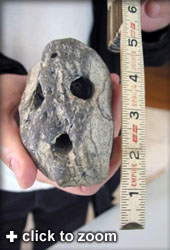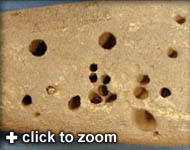Alien Skull Investigation
by Sherri Andrews
 February
12, 2004 - The IIG was contacted on December 15, 2003, by a gentleman claiming that
he believed that he was in possession of an "alien skull." He subsequently
submitted numerous photographs of the object, which on first glance looked
like a rock that resembled a face, the "features" of which were comprised of
a "mouth" and two "eyes." These appeared to be holes that were drilled into
the rock. One IIG member, Sherri Andrews, recognized that the holes were
reminiscent of those made by rock-boring clams.
February
12, 2004 - The IIG was contacted on December 15, 2003, by a gentleman claiming that
he believed that he was in possession of an "alien skull." He subsequently
submitted numerous photographs of the object, which on first glance looked
like a rock that resembled a face, the "features" of which were comprised of
a "mouth" and two "eyes." These appeared to be holes that were drilled into
the rock. One IIG member, Sherri Andrews, recognized that the holes were
reminiscent of those made by rock-boring clams.
While it would have been easy enough to dismiss the "skull" as the rock that
it obviously was, the IIG decided to pursue the investigation further in
order to be able to provide the claimant with as much evidence as possible
to convince him as well. Sherri was made lead investigator, since she was
familiar with the likely cause of the phenomenon and had some scientific
contacts that could be asked for assistance.
Sherri made contact with Dr. Lindsey Groves, Collection Manager of
Malacology at the Los Angeles County Natural History Museum. Dr. Groves
examined the photos and concurred that the phenomenon was likely caused by
the action of rock-boring clams. Sherri subsequently visited the museum and
examined many examples of such rock with the clams still in situ. Dr. Groves
also provided basic information on the two types of rock-boring clams and
how they live.
In addition, Sherri made contact with Dr. Kevin Pope, a geomorphologist who
runs Geo Eco Arc Research and has been involved in research that has led to
significant conclusions about the extinction of the dinosaurs. Dr. Pope also
immediately agreed that the photos appeared to depict a rock with holes made
by rock-boring clams.


On February 21, 2004, an investigative team (Jim Underdown, Sherri Andrews,
Brian Hart, and Trey Stokes) traveled to the home of the gentleman in
possession of the rock in Lake Elsinore, California, in order to confirm our
suspicions in person. Our initial interview with the gentleman in his home
was taped and examination of the artifact took place. Among other pieces of
information that were gleaned from our time spent there was the fact that
after the artifact had been originally found on the beach, the grandson of
the original finder was busily digging seashell fragments out of the holes.
Upon examination, it was very clear that the artifact was in fact a rock.
The claimant was informed of our final conclusion in March 2004, after which
we received no further communication from him.







